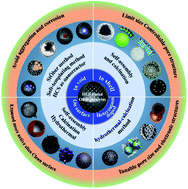Surface and interface engineering of hollow carbon sphere-based electrocatalysts for the oxygen reduction reaction
Abstract
Hollow carbon spheres (HCSs) attract broad interest in the area of electrocatalysis, especially in the oxygen reduction reaction (ORR) owing to their high surface area, abundant accessible active sites, discrete voids, and uniform channel/pore structures. Recently, advances have been made in surface and interface engineering of HCS-based ORR electrocatalysts that include single atom anchored HCSs, heteroatom doped HCSs, nanoparticle confined HCSs, and dual/triple-layer structured HCSs. In this comprehensive review, we summarize and discuss recent advances in engineering the surface and interface of HCSs that act as efficient ORR electrocatalysts. We firstly introduce the design and fabrication strategies of HCS-based materials. Then, the ORR mechanism and theoretical approaches of HCS-based electrocatalysts are analyzed. We discuss in detail about the recent developments of HCS-based electrocatalysts for efficient ORR, particularly focusing on surface and interface engineering approaches, which include materials confinement in the void, surface modification, shell confinement, and heteroatom doping. Finally, we propose future directions for surface and interface engineering of HCSs for efficient ORR electrocatalysts.



 Please wait while we load your content...
Please wait while we load your content...